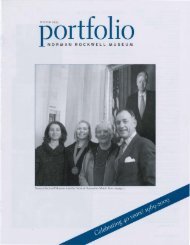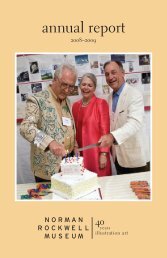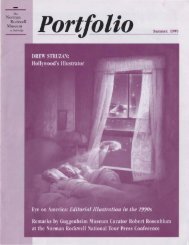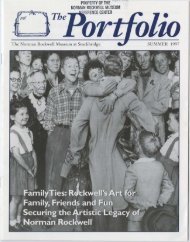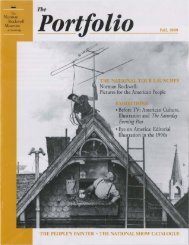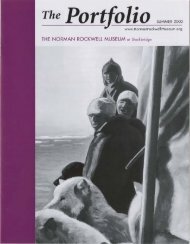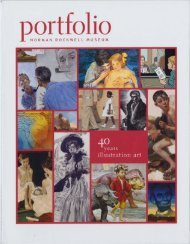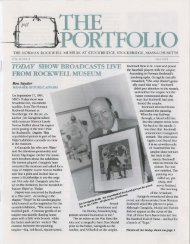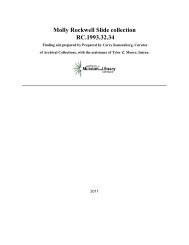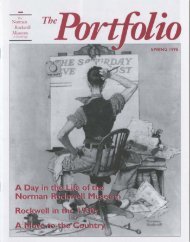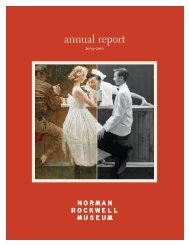The·po ~olio Volume 19 Issue 2 2002 - Norman Rockwell Museum
The·po ~olio Volume 19 Issue 2 2002 - Norman Rockwell Museum
The·po ~olio Volume 19 Issue 2 2002 - Norman Rockwell Museum
Create successful ePaper yourself
Turn your PDF publications into a flip-book with our unique Google optimized e-Paper software.
The ·po <strong>~olio</strong> <strong>Volume</strong><br />
<strong>19</strong><br />
<strong>Issue</strong> 2 <strong>2002</strong>
The<br />
<strong>Norman</strong><br />
<strong>Rockwell</strong><br />
<strong>Museum</strong><br />
at Stockbridge<br />
BOARD OF TRUSTEES<br />
Bobbie Crosby· President<br />
Perri Petricca • First Vice President<br />
Lee Williams' Second Vice President<br />
Steven Spielberg· Third Vice President<br />
James W. Ireland' Treasurer<br />
Roselle Kline Chartock • Clerk<br />
Robert Berle<br />
Ann Fitzpatrick Brown<br />
Daniel M. Cain<br />
Jan Cohn<br />
Catharine B. Deely<br />
Michelle Gillett<br />
Elaine S. Gunn<br />
Ellen Kahn<br />
Jeffrey Kleiser<br />
Luisa Kreisberg<br />
Harvey Chet Krentzman<br />
Thomas D. McCann<br />
John C. (Hans) Morris<br />
Barbara Nessim<br />
Brian J. Quinn<br />
Tom <strong>Rockwell</strong><br />
Edward A. Scofield<br />
Mark Selkowitz<br />
Diana Walczak<br />
Richard B. Wilcox<br />
Jamie Williamson<br />
TRUSTEES EMERITI<br />
lila Wilde Berle<br />
Jane P. Fitzpatrick<br />
Norma G. Ogden<br />
Henry H. Williams, Jr.<br />
Laurie Norton Moffatt, Director<br />
The P011folio<br />
<strong>Volume</strong> J 9, <strong>Issue</strong> 2, <strong>2002</strong><br />
Kimberly Rutberg, Project Manager<br />
Cris Raymond, Editor<br />
Mary Herrmann, Designer<br />
The Portfolio is published four times a<br />
year by the <strong>Norman</strong> <strong>Rockwell</strong> <strong>Museum</strong><br />
at Stockbridge, Inc., and is sent free<br />
to all members.<br />
© <strong>2002</strong> by the <strong>Norman</strong> <strong>Rockwell</strong><br />
<strong>Museum</strong> at Stockbridge. All rights<br />
reserved.<br />
Cover: Northward, John Held, Jr.,<br />
lithograph on paper, t'avel poster,<br />
The New Haven Railroad. © <strong>19</strong>35.<br />
Reproduced with permission of<br />
Illustration House, New York City,<br />
and the estate of Margaret Held.<br />
From the Director<br />
I am pleased to announce the formation<br />
of the <strong>Norman</strong> <strong>Rockwell</strong> <strong>Museum</strong> National<br />
Council, upon the conclusion of our<br />
national tour, Pictures for the American<br />
People. The Council will provide a forum<br />
for the <strong>Museum</strong>'s national patrons and<br />
collectors, who will serve as ambassadors<br />
for the <strong>Museum</strong> across the nation.<br />
The Board of Trustees has nominated a<br />
select group of friends and supporters to<br />
join us in the stewardship of our mission.<br />
The Council is advisory to and complements<br />
the work of <strong>Norman</strong> <strong>Rockwell</strong> <strong>Museum</strong><br />
Trustees and staff. Council members will<br />
provide national outreach and offer advice<br />
in strategic planning, program initiatives<br />
and endowment and art acquisition in<br />
support of the <strong>Museum</strong>'s goals. They will<br />
host and participate in occasional regional<br />
gatherings and conversations with Trustees,<br />
members and senior <strong>Museum</strong> staff. Council<br />
members will meet annually in Stockbridge<br />
to learn about <strong>Museum</strong> programs and exhibitions,<br />
share ideas about illustration and<br />
<strong>Norman</strong> <strong>Rockwell</strong>.<br />
Our first juried sculpture exhibition held<br />
this spring was a great success. New Digs for<br />
the Dog: Build a Better Dog House for Snoopy,<br />
commenced with a day-long family event<br />
sponsored by Berkshire Gas, Greylock Credit<br />
Union, and Perri and Patricia Petricca. Activities<br />
included a dog show, a Snoopy lookalike<br />
contest and silent auction of the more<br />
than 50 full-sized and miniature doghouse<br />
sculptures that graced the lawns and galleries.<br />
Warm thanks to the judges Paul Ivory,<br />
former director of Chesterwood, artist Jarvis<br />
<strong>Rockwell</strong>, and Deborah Solomon, New York<br />
Times art critic and biographer, for their<br />
work in jurying the sculpture show.<br />
the museum will offer<br />
a sampler of foods to<br />
museum visitors at<br />
our new Terrace Cafe<br />
during the summer and fall. Sip a refreshing<br />
iced tea and enjoy the view after your visit to<br />
our wonderful summer exhibitions. We thank<br />
the Town of Stockbridge Board of Selectmen<br />
and the Red Lion Inn for being our partner in<br />
offering hospitality to our visitors.<br />
As part of the Berkshire County-wide arts<br />
festival, the Vienna Project, the museum<br />
opened Viennese illustrator Lisbeth Zwerger's<br />
Land of Oz with a Viennese coffee house,<br />
remarks by Dr. Harald Miltner, Austrian<br />
Consul General from New York, and beautiful<br />
floral displays by the Berkshire District<br />
Garden Clubs. This exhibition complements<br />
Toast of the Town: <strong>Norman</strong> <strong>Rockwell</strong> and the<br />
Artists of New Rochelle, and John Held, Jr. and<br />
the Jazz Age, our summer exhibits. Members<br />
danced to music of the Roaring Twenties in<br />
costume on the <strong>Museum</strong> terrace in early<br />
June. We thank Tom and Carol McCann<br />
and two very generous members who wish<br />
to remain anonymous for sponsoring this<br />
summer's offerings.<br />
I close with thanks to a very special museum<br />
volunteer, Cris Raymond, who for more<br />
than 10 years has assisted the <strong>Museum</strong> as<br />
editor of the Portfolio. She has also made an<br />
important contribution to the organization<br />
of the <strong>Norman</strong> <strong>Rockwell</strong> archives. Her work<br />
has been a labor of love and we will miss<br />
her. We wish you all the best Cris!<br />
I hope to see you in Stockbridge this summer!<br />
The <strong>Norman</strong> <strong>Rockwell</strong> <strong>Museum</strong> Is funded in<br />
part by the Massachusetts Cultural Council, a<br />
state agency that supports public programs In<br />
the arts, humanities, and sciences.<br />
Berger funds Is proud to be a supporter of<br />
keeping the arts alive and well in the Berkshlres.<br />
A very special summer is unfolding at the<br />
museum in Stockbridge. For the first time,<br />
2<br />
Laurie Norton Moffatt
Current & Upcoming Exhibitions<br />
John Held, Jr. and the Jazz Age<br />
Journey back to the days of flappers, jazz bands and bathtub<br />
gin! More than any other artist of his time, John Held, Jr.<br />
expressed in his paintings the brash spirit of the Roaring<br />
Twenties. His highly stylized drawings perfectly matched<br />
the aesthetics of the era, and his work was in high demand<br />
by the publications of the day. This exhibition examines<br />
Held's artistic evolution through original drawings and<br />
paintings, sculpture, artifacts and archival photographs.<br />
Discover why John Held, Jr. was considered the "the cat's<br />
meow" during the Jazz Age! This exhibition is on view<br />
through September 8.<br />
Lisbeth Zwerger's Land of Oz<br />
June 29, <strong>2002</strong>-Sept. 2, <strong>2002</strong><br />
Explore the art and process of<br />
renowned Austrian children's<br />
book illustrator Lisbeth Zwerger<br />
in these delightful new illustrations<br />
of 1. Frank Baum's classic<br />
tale, The Wonderful Wizard of Oz.<br />
Art Critic. <strong>Norman</strong> <strong>Rockwell</strong>. oil on canvas. Saturday Evening Post © <strong>19</strong>55 SEPS: Licensed<br />
by Curtis Publishing. Indianapolis. IN.<br />
Return of the Permanent Collection<br />
Following the closing of the enormously successful national<br />
tour, Pictures for the American People, the <strong>Museum</strong> is celebrating<br />
the reinstallation of its <strong>Norman</strong> <strong>Rockwell</strong> permanent<br />
collection. Favorites such as Triple Self-Portrait, The Art<br />
Critic, Girl at Mirror and the Four Freedoms paintings have<br />
returned to the <strong>Museum</strong>.<br />
Toast of the Town:<br />
<strong>Norman</strong> <strong>Rockwell</strong> and the Artists of New Rochelle<br />
During the <strong>19</strong>20s and <strong>19</strong>30s, New Rochelle attracted<br />
many of the nation's leading illustrators, who were drawn to<br />
the town's proximity to the hustle and bustle of that mecca<br />
for artists-Manhattan. Such artists as J.e. and EX.<br />
Leyendecker, e. Coles Phillips, Walter Beach Humphrey,<br />
Clare Briggs, Clyde Forsythe, Frederic Remington, Worth<br />
Brehm and Edward Penfield lived in the community. The<br />
works of <strong>Rockwell</strong> and his artist neighbors are presented in<br />
this exhibition, which runs through October 27.<br />
Dancing by the Light of the Moon:<br />
The Art of Fred Marcellino<br />
Nov. 9, <strong>2002</strong>-Jan. 26, 2003<br />
See how the illustrator of such<br />
classics as Puss in Boots permanently<br />
changed the look and feel<br />
of book covers and jackets for<br />
children's books and adult fiction.<br />
Puss from Puss in Boots © <strong>19</strong>90 Fred Marcellino.<br />
The Berenstain Bears Celebrate:<br />
The Art of Stan and Jan Berenstain<br />
Feb. 8, 2003-May 27,2003<br />
© <strong>19</strong>96 by Michael Neugebauer.<br />
Verlag AG. Gossau Zurich. Switzerland.<br />
Enjoy the art of one of the most successful author/illustrator<br />
teams in publishing history, from early magazine covers to<br />
their popular family of cartoon bears.<br />
3
John Held, Jr.<br />
Irreverent<br />
Walt Reed, founder of Illustration House and guest curator of John Held, Jr. and the Jazz Age<br />
The First World War interrupted all<br />
this. John joined the Navy and was<br />
assigned to intelligence, where he<br />
employed his artistic abilities. Sent to<br />
Central America, ostensibly as a civilian<br />
working for the Carnegie Institute<br />
making copies of Mayan ruins, John's<br />
real work was to make maps and spy<br />
on nearby German military installations<br />
and U-boat activities. Enduring<br />
the heat, mosquitoes and sand fleas,<br />
he also managed to paint many watercolors<br />
of the tropic sites for himself.<br />
4<br />
The Adventures of Miss Cel/a Uoyd, pen and ink wash on board. © <strong>19</strong>26, McClure's magazine, reproduced with permission of<br />
Illustration House, New York City. and the estate of Margaret Held.<br />
John Held, Jr. (1889-<strong>19</strong>58) was a<br />
complete artist with talents in many<br />
directions, all of which he employed<br />
at various times in his long career.<br />
Born in Salt Lake City, of Mormon<br />
parentage, he drew from early childhood<br />
and was given some basic art<br />
instruction by the sculptor Mahonri<br />
Young (grandson of the Mormon<br />
leader Brigham Young). Held's interests,<br />
however, were entirely secular.<br />
He landed a job as a sports cartoonist<br />
on the Salt Lake City Tribune, where<br />
he worked alongside cub reporter<br />
Harold Ross, the future founder of<br />
The New Yorker magazine. Held<br />
married the newspaper's pretty society<br />
editor and together they soon left for<br />
fame and fortune in the big city, arriving<br />
in New York in <strong>19</strong>10.<br />
Fame was quite a while coming. Held<br />
had not yet developed an individual<br />
artistic style, and he wasn't able to<br />
sell his gags to the humor magazine<br />
he had set his sights on, so he had to<br />
settle for any kind of art job he could<br />
find. His first employment was with<br />
the Collier's Street Railway Advertising<br />
Company, where he lettered streetcar<br />
cards. After gaining more experience,<br />
he graduated to making advertising ads<br />
and posters for the John Wanamaker<br />
department store, where he stayed for<br />
a year and a half.<br />
He also kept submitting gag cartoons,<br />
but was still being rejected with monotonous<br />
regularity. Finally, using the<br />
stratagem of trading on his wife's good<br />
looks, he signed his drawings "Myrtle"<br />
Held, and she visited the art editors in<br />
person to try to sell the pictures. Her<br />
charm worked. By <strong>19</strong>16, John, as<br />
Myrtle, was selling to Vanity Fair, Life,<br />
Judge and other top magazines.<br />
Separated from his wife, and a postwar<br />
civilian again, John was ready to<br />
reclaim his own artistic name. He also<br />
was armed with a new authority in his<br />
drawing and a new subject. While he<br />
did not exactly invent the "Flapper:' he<br />
recognized the potential attraction of<br />
the post-war emancipated woman and<br />
evolved the perfect style to interpret<br />
and magnify her. His long-legged,<br />
short-skirted, flat-bosomed, bobbedhair<br />
heroines were provocative and<br />
irreverent. The magazines and public<br />
could not get enough of them.<br />
Although flappers and their "Joe Prep"<br />
consorts were presented as hedonistic<br />
simpletons, they provided the perfect<br />
foil to be spoofed. Held was enough<br />
older than his subjects that he could<br />
see their foibles more objectively than<br />
they could see themselves. What was<br />
satire to him became reality to them.<br />
Not that he was apart from the twenties<br />
mania himself. It was a boom<br />
time. He was making a lot of
Chronicler of the Jazz Age<br />
money-advertisers and publishers<br />
competed for his talents with open<br />
checkbooks. He bought a large farm in<br />
Connecticut that he could only manage<br />
part-time, had a beach house in<br />
Florida that he seldom visited and a<br />
handsome New York penthouse studio<br />
and apartment. Held's pictures of<br />
flappers were used everywhere--on<br />
magazine covers, for story illustrations,<br />
gag cartoons, cocktail glasses, card<br />
games and jigsaw puzzles; they advertised<br />
products from roller bearings to<br />
clothing dyes. At the same time, Held<br />
was publishing a series of linoleum<br />
block prints that mimicked the crude<br />
wood 'engravings of the old Police<br />
Gazette and ridiculed the Victorian era.<br />
These were targeted for The New Yorker<br />
magazine at the request of his old<br />
friend Harold Ross. Held was a<br />
regular judge at Miss America beauty<br />
contests. He was also active in the<br />
theater. He designed the sets and costumes<br />
for Broadway plays and revues<br />
in <strong>19</strong>25 and <strong>19</strong>26, as well as posters<br />
for Hollywood films.<br />
At the height of this frenetic pace, in<br />
March <strong>19</strong>25, Held, who retreated to<br />
his farm whenever he could, suffered a<br />
major accident that nearly ended his<br />
life. He had hitched his heavy<br />
Percheron mare to a wagon and was<br />
headed to town down a steep incline<br />
when the wagon box came loose. Held<br />
was thrown onto the road, and the<br />
agitated horse, trying to free itself from<br />
the entangled harness, stepped on his<br />
head. Held was immediately rushed to<br />
the hospital, where an expert brain surgeon<br />
repaired a severed artery and an<br />
indented fracture, thereby saving his life.<br />
During the months of recovery,<br />
friends filled in for him at his comic<br />
strip by reworking his old drawings<br />
and sketches to new dialogue, with<br />
the assistance of fellow cartoonist<br />
Charles Winner. As soon as Held was<br />
back at work, he picked up his same<br />
frantic pace. Shortly afterwards, newspaper<br />
magnate William Randolph<br />
Hearst made an offer to Held with a<br />
guarantee five to six times larger than<br />
what he had previously been paid<br />
for his Oh! Margy comic strips. John<br />
quipped that he was never successful<br />
as an artist until he got kicked in the<br />
head by a horse.<br />
In addition to the Oh! Margy strip,<br />
Held resumed his load of magazine<br />
and advertising work. In October<br />
<strong>19</strong>25, a typical month, Held's work<br />
was published in the New Yorker four<br />
times, once in College Humor (a double-page<br />
spread), in Life three times<br />
and in Judge ten times with reproductions.<br />
As he described the pace, he<br />
hardly had time to look up from his<br />
drawing board.<br />
Held's second wife, "Johnny;' was a<br />
twenties party girl who matched his<br />
workload with her own social pace.<br />
The house was always filled with<br />
guests, noise and celebrating, which<br />
interfered with his work. Yet he had to<br />
maintain a consistent output to keep<br />
She M;ssed the Boa~ gouache on board. © <strong>19</strong>27, U(e magazine,<br />
courtesy of Illustration House, New York City, and the<br />
estate of Margaret Held.<br />
up with her spending. They also<br />
adopted three children, but the marriage<br />
was coming apart and soon<br />
ended. Held buried himself in even<br />
more work and retreated to Manhattan.<br />
This all ended with the crash of the<br />
stock market. He lost all of his money,<br />
some $6 million, as well as his means<br />
to recoup the losses. The Flapper image<br />
became irrelevant as the Depression<br />
deepened, and Held's mode of<br />
expression was too closely identified<br />
with her. Even his comic strip, then<br />
renamed Merely Margy, could not<br />
counter the gloomy national mood,<br />
and it ended in <strong>19</strong>35. Having to reinvent<br />
himself, Held turned to writing.<br />
A natural theme was a look back at<br />
the twenties, not as a protagonist, but<br />
as a critic. He wrote an unproduced<br />
play and several novels. However, their<br />
disillusioned viewpoint was rather too<br />
5
~<br />
I<br />
And How Many Carbons, Sir? © <strong>19</strong>3 I , reproduced with permission of<br />
Illustration House, New York City. and the estate of Margaret Held.<br />
grim, and although his books were published,<br />
they did not sell well. The public expected<br />
him to be funny. Two songbooks illustrated<br />
with Victorian-style linoleum cuts were<br />
published and sold somewhat better, but the<br />
royalties were limited.<br />
Held next tried sculpture, focusing on horses<br />
and other animals. He had a sure sense of the<br />
medium, and several of his casts sold at his<br />
New York exhibition, but not enough to support<br />
him. Next, in a related field of metal<br />
work, Held experimented with wrought iron,<br />
making signs, weather vanes and other artifacts<br />
in his forge. He also continued to paint,<br />
using watercolors to record his travelsscenes<br />
from the wildlife of the Adirondacks<br />
to the canyons of New York skyscrapers.<br />
In <strong>19</strong>32, he married "Miss New Orleans." Their<br />
brief union produced a daughter, but she was<br />
not enough to hold the marriage together.<br />
Alone again, his fortune began to change for<br />
the better. He conducted a popular college<br />
variety show for NBC radio and became a<br />
consultant and, in <strong>19</strong>38, a designer for the hit<br />
Broadway review, Hellzapoppin! In <strong>19</strong>40, he<br />
was chosen as artist in residence at Harvard<br />
University, and later at the University of Georgia,<br />
where he continued with his sculpture.<br />
Held tried to enlist when World War II came<br />
along, but the army turned him down because<br />
of his age. Instead, he worked as a civilian for<br />
the Signal Corps, assigned to a unit in New<br />
Jersey working on the development of a secret<br />
project later known as radar. He also married<br />
his fourth wife, Maggie James. Together, they<br />
bought a small five-acre farm that they gardened<br />
and stocked with a range of animals<br />
from chickens, guinea hens and goats to a<br />
carefully trained dog that acted as a shepherd<br />
and kept the goats and roosters in line. These<br />
animals also became models and subjects for<br />
several successful children's stories that combined<br />
his writing and art in a new phase of<br />
his career.<br />
Held collaborated with the author Frank B.<br />
Gilbreth, Jr. to produce a more successful<br />
book, Held's Angels. It reprinted many of his<br />
earlier cartoons and led to a revival of interest<br />
in his old work. A new audience was<br />
discovering him.<br />
Despite the wide swings of his fortunes, the<br />
most constant of Held's characteristics was an<br />
irrepressible and irreverent sense of humor.<br />
"It's something like a mild form of halfwittedness<br />
that makes a man want to<br />
earn his living in some such ridiculous<br />
way as this .... Every child can create,<br />
but almost every child grows up and<br />
goes into some sensible business like<br />
selling bonds. Some don't. I think<br />
there's a door in the back of everybody's<br />
head that lets out the dreams,<br />
or the creative instinct, or the mild<br />
madness or whatever you want to call<br />
it that makes us want to make our<br />
living this way, and not sensibly. For<br />
the lucky ones, that door closes at<br />
puberty; the unfortunates go on all<br />
their lives fighting with publishers or<br />
art dealers. They never grow up, and<br />
don't say 'Peter Pan' or I'll sock you."<br />
-John Held Jr. in the New Orleans Times Picayune, <strong>19</strong>34
Toast of the Town<br />
<strong>Norman</strong> <strong>Rockwell</strong> and the Artists of New Rochelle<br />
Maureen Hart Hennessey, Chief Curator, and Stephanie Plunkett, Curator of Illustration<br />
"In New Rochelle I was surrounded by success .... Downtown<br />
I often saw Coles Phillips, the celebrated pretty-girl<br />
artist, or Clare Briggs, the well-known cartoonist. Almost<br />
every day on my way to work I'd pass J. C. Leyendecker,<br />
the famous Saturday Evening Post illustrator, walking to<br />
the railroad station to catch the train for New York, where<br />
he had his studio. Sometimes, as I was taking a model<br />
home at dusk, I'd pass his palatial mansion with its formal<br />
gardens, wide lawns and white-graveled drive."<br />
- <strong>Norman</strong> <strong>Rockwell</strong><br />
No Swimming. illustrated by <strong>Norman</strong> <strong>Rockwell</strong>. oil on canvas.<br />
The Saturday Evening Pos~ June 4. <strong>19</strong>21. cover. © <strong>19</strong>21 SEPS:<br />
Licensed by Curtis Publishing. Indianapolis. IN.<br />
Known as the Queen City of the<br />
Sound, New Rochelle, New York, a<br />
northern suburb of New York City,<br />
was one of America's most popular<br />
enclaves for illustrators during the<br />
early twentieth century. Commuter<br />
trains to Grand Central Station, just<br />
16 miles away, provided easy access to<br />
New York City, the country's primary<br />
center of publishing. With its sophisticated<br />
social and cultural milieu, many<br />
prominent artists and illustrators were<br />
inspired to become a part of New<br />
Rochelle's vibrant community.<br />
In <strong>19</strong>28, "two pretty harbors ... with<br />
many inlets that comb the shoreline"<br />
of the Long Island Sound, and the<br />
evidences of artistic influence that<br />
"meet you at every entrance of town<br />
and color every quarter of it:' were<br />
touted by the Chamber of Commerce.<br />
In its illustrated booklet, the Chamber<br />
featured the work of New Rochelle's<br />
most celebrated picture makers<br />
<strong>Norman</strong> <strong>Rockwell</strong>, J.e. Leyendecker,<br />
EX. Leyendecker, Edward Penfield,<br />
Orson Lowell, Walter Beach Humphrey,<br />
Edward Penfield, e. Coles Phillips and<br />
George T. Tobin. The influence of<br />
these outstanding artists, who were<br />
among the celebrities of their day, was<br />
strongly felt on the pages of the magazines,<br />
newspapers and illustrated<br />
books of the period.<br />
<strong>Norman</strong> <strong>Rockwell</strong> lived in New<br />
Rochelle for the better part of 27<br />
years, from <strong>19</strong>13 to <strong>19</strong>40. He was <strong>19</strong><br />
when his family took up residence in<br />
a local boardinghouse, and he set out<br />
to build his career as a successful<br />
illustrator. After three years as an art<br />
editor of Boys' Life and with a portfolio<br />
of work for other clients, he sold his<br />
first cover to The Saturday Evening<br />
Post in <strong>19</strong>16. This was an important<br />
step for the artist.<br />
Following a brief stint in the United<br />
States Navy during World War I, his<br />
professional reputation grew, as did the<br />
list of publications that commissioned<br />
his art. In <strong>19</strong>25, the first of <strong>Rockwell</strong>'s<br />
Boy Scout calendars was published-a<br />
series that was to continue until <strong>19</strong>76.<br />
In addition, his works featuring such<br />
products as Edison Mazda electric<br />
lights and Raybestos automobile brakes<br />
were highly regarded advertisements.<br />
During his years in New Rochelle,<br />
<strong>Rockwell</strong> formed close friendships<br />
7
A Modern Witch, illustrated by F.x, Leyendecker. Ufe magazine. <strong>19</strong>23. © The Kelly Collection<br />
of American Illustration.<br />
Woman with Hounds, illustrated by Edward Penfield. watercolor on board. <strong>19</strong>06. © The<br />
Kelly Collection of American Illustration.<br />
with resident artists Joe and Frank<br />
Leyendecker and noted cartoonist<br />
Victor Clyde Forsythe, who encouraged<br />
<strong>Rockwell</strong> to submit cover ideas<br />
to the Post. The two of them shared<br />
Frederic Remington's former sculpture<br />
studio. At events sponsored by the<br />
New Rochelle Art Association, which<br />
held annual exhibitions featuring<br />
the work of regional artists,<br />
<strong>Rockwell</strong> had the opportunity to mingle<br />
with famous American illustrators.<br />
In <strong>19</strong>39, while his professional accomplishments<br />
and active social life<br />
flourished, <strong>Rockwell</strong>'s 13-year<br />
8<br />
marriage to Irene O'Connor ended.<br />
In <strong>19</strong>30, while visiting Forsythe, who<br />
had moved to California, <strong>Rockwell</strong><br />
met and married a young schoolteacher<br />
named Mary Barstow, and<br />
the two returned to New Rochelle to<br />
live. The <strong>19</strong>30s would prove to be one<br />
of the richest in <strong>Rockwell</strong>'s personal<br />
and professional life. The couple had<br />
three sons, and, in addition to his<br />
illustrations for the Post and other<br />
magazines, he received important<br />
commissions to illustrate Mark<br />
Twain's classics The Adventures of<br />
Tom Sawyer and The Adventures of<br />
Huckleberry Finn.<br />
Toast of the Town: <strong>Norman</strong> <strong>Rockwell</strong><br />
and the Artists of New Rochelle will be<br />
on view at the <strong>Museum</strong> through October<br />
27, <strong>2002</strong>. This special exhibition<br />
offers an in-depth look at the community<br />
of illustrators who lived and<br />
worked in New Rochelle, New York,<br />
during <strong>Rockwell</strong>'s time there. It also<br />
explores the relationships, styles and<br />
influences of these outstanding artists<br />
as well as the unique nature of New<br />
Rochelle as an artistic outpost during<br />
the early twentieth century.<br />
Original works by <strong>Norman</strong> <strong>Rockwell</strong><br />
and 25 noted illustrators are featured,
Bar Scene, illustrated by Franklin Booth. date unknown. © The<br />
Kelly Collection of American Illustration.<br />
The Magic Hour, illustrated by C. Coles Phillips. <strong>19</strong>24. advertisement. Oneida<br />
Si lverPlate. © The Kelly Collection of American Illustration<br />
including Harold Anderson, Franklin<br />
Booth, George Brehm, Worth Brehm,<br />
Clare Briggs, Nell Brinkley, Daniel Content,<br />
Dean Cornwell, John Philip Falter, Victor<br />
Clyde Forsythe, Walter Beach Humphrey,<br />
EX. Leyendecker, J.e. Leyendecker, Orson<br />
Byron Lowell, Tom Lovell, Al Parker,<br />
Edward Penfield, e. Coles Phillips,<br />
Frederic Remington, Mead Schaeffer,<br />
Remington Schuyler, Donald Teague,<br />
George T. Tobin, Edmund E Ward and<br />
Revere Wistefuff.<br />
The Other Women Criticize Her. illustrated by Orson Byron Lowell.<br />
ink on paper. judge magazine. <strong>19</strong>06.<br />
© The Kelly Collection of American Illustration.
Steve Buchanan, illustrator<br />
In his autobiography, <strong>Norman</strong><br />
<strong>Rockwell</strong> wrote that he was somewhat<br />
embarrassed to admit to his colleagues<br />
that he had gone over to the "new technology"<br />
and was using photography as<br />
an aid to his art. He wrote, "It was<br />
quicker, easier, and you could catch the<br />
model's expression (no more frozen<br />
smiles) and any action you wanted."<br />
We asked a contemporary illustrator<br />
how today's technology-computer<br />
graphics-has effected his work and<br />
the field of illustration.<br />
The creation of art has always been<br />
an exercise of technology that realizes<br />
the artist's vision. We frequently<br />
lose sight of that fact because so many<br />
of our artistic icons, from old-master<br />
paintings to the work of the great<br />
twentieth-century illustrators, used<br />
tools that had not changed much for<br />
generations-pencils, charcoal, oil<br />
paint or watercolor. In the last century,<br />
every improvement in art technology<br />
has been accompanied by an uneasy<br />
feeling, both among artists and<br />
among their viewers, that these new<br />
methods were somehow not artistic,<br />
or that they signaled a general aesthetic<br />
decline, or that they were in<br />
some vague way "cheating."<br />
Seventy-five years ago, many felt<br />
that the use of photographs as quick<br />
substitutes for live sketches was<br />
beneath "real" artists. As recently as<br />
10<br />
15 years ago, I occasionally encountered<br />
the attitude that the use of<br />
"modern" inventions like acrylic<br />
paint or airbrushes were lamentable<br />
expedients of the commercial art<br />
world, not to be confused with true<br />
art. Today, it is computer graphic<br />
tools that are suspect. There is a feeling<br />
that computers are cold, mechanical<br />
and unexpressive; and the fear<br />
that computers might drive some<br />
beloved traditional media to extinction.<br />
And there is uncertainty over<br />
just exactly what we should regard as<br />
the "original" work of art: is it the file<br />
on a CD, the image on a monitor, the<br />
image the artist produces on his desktop<br />
printer, or is it something else?<br />
How can we call it art if there is no<br />
unique "original" painting?<br />
Having spent a decade exploring<br />
the potential of computers as an art<br />
medium, I'm happy to report that<br />
they offer many advantages of speed<br />
and fluency as well as exciting new<br />
"painting" strategies that have no<br />
equivalent in older media. But, like<br />
preceding technological innovations,<br />
they haven't really changed the visual<br />
skills and conceptual processes artists<br />
use to realize their vision. Artists who<br />
lack skills of draftsmanship, knowledge<br />
of the rendering of light on<br />
form, perspective, anatomy, atmospheric<br />
effects, etc., or who do not<br />
understand their subjects or their<br />
audience will find that computers<br />
do not magically automate those<br />
skills. For illustrators who primarily<br />
create images destined for print<br />
reproduction, computers have one<br />
further advantage. Since every step of<br />
commercial printing, from page<br />
design to typesetting to scanning to<br />
color separation to press operation, is<br />
computer controlled today, creating<br />
original images digitally comes very<br />
close to "painting" directly in the<br />
medium of the printing press.<br />
Most digital art can be done on<br />
ordinary desktop computers with<br />
commonly available software. To<br />
my traditionally trained sensibilities,<br />
the tool that gives a general imageediting<br />
program like Adobe Photoshop<br />
the potential to be a fluent<br />
drawing! painting medium is the pen<br />
tablet (sometimes called a digitizing<br />
tablet). It is a plastic tablet (mine is<br />
about 12 inches square) that comes<br />
equipped with a plastic stylus resembling<br />
a cheap ballpoint pen. Touch<br />
the stylus to the tablet, and corresponding<br />
marks appear on the monitor.<br />
The tablet responds to pressure<br />
and speed as sensitively as any conventional<br />
pencil or brush. Best of all,<br />
it is possible to direct programs to<br />
make it work as everyone intuitively<br />
expects, e.g., when you press harder<br />
on the stylus, marks get darker<br />
and/or wider.
MAKE ART?<br />
To look at how computer art is<br />
created today, we can follow the<br />
development of the imagery for the<br />
Carnivorous Plants commemorative<br />
stamps that the United States Postal<br />
Service commissioned me to illustrate.<br />
Every stamp illustration (like most<br />
other illustration assignments)<br />
requires a lot of research. For this<br />
assignment, I visited several botanical<br />
gardens to photograph and sketch<br />
native carnivorous plants on display.<br />
My research in the New York Botanical<br />
Garden library included tracking down<br />
books, photos, maps and diagrams.<br />
For every species native to the United<br />
States, I needed to know its size, color<br />
variations within the species, the<br />
One of many concept sketches for the Carnivorous Plants<br />
commemorative stamps.<br />
morphological details that define it,<br />
its native range and anything else that<br />
might be useful in choosing appropriate<br />
examples for a stamp design.<br />
From approved concept sketches, this rnal outline of important<br />
scientirc details was used as a guide for rendering.<br />
I bought several common varieties of<br />
carnivorous plants at nearby nurseries<br />
to use as guides for surface texture<br />
and degree of transparency, which<br />
are not captured well in photographs<br />
or sketches.<br />
Next, I made a few concept sketches<br />
for the art director, Phil Jordan. For<br />
these, I started with the blank stamp<br />
format at its actual size, which is<br />
bounded by the wavy line of the selfadhesive<br />
perforation, along with<br />
I<br />
~<br />
•<br />
i<br />
I<br />
j<br />
i<br />
l<br />
,..<br />
~<br />
0<br />
The rnished stamp design.<br />
dummy type to show the space that<br />
will be needed for the stamp's face<br />
value. Adobe Photoshop enables the<br />
stylus to act like a black pencil, so the<br />
resulting sketches look quite similar<br />
to ordinary pencil drawings. With<br />
Photoshop, it is easy to overlay a<br />
quick color wash that is separate from<br />
the "pencil" drawing underneath, and<br />
to duplicate the sketches to mock up a<br />
standard pane of 20 stamps in different<br />
patterns. This gives a fairly good<br />
sense of the concept design effect with<br />
not much more work than would be<br />
required for traditional pencil roughs<br />
of the separate stamps. Furthermore,<br />
since I can send the sketch flies to my<br />
art director via e-mail, and since it is<br />
easy to make changes to the e-sketches,<br />
we have much more flexibility to<br />
experiment and exchange ideas at the<br />
earliest design stages.<br />
Once a direction is approved, I make a<br />
more accurate black-and-white drawing<br />
of the individual stamp subjects.<br />
1<br />
~<br />
•<br />
j<br />
J<br />
j<br />
i<br />
,.. l<br />
~<br />
0<br />
II
'( This resolves the exact sizes of J otani:<br />
ca Iy or entomologic~l1fimportaI"\t<br />
details, serves to check the 6t of t;he<br />
projected type elements artd ~ay be<br />
sent out to expert consul~ants (scientists,<br />
in this case) for a preliminary<br />
technical review.<br />
I '<br />
»<br />
in ally, it's time to render the mal<br />
color art. At this stage, I treat the tablet<br />
and Photoshop as a generalized painting<br />
medium. It can "paint" with individual<br />
strokes like a paintbrush. It can<br />
cut masks and create airbrush effects<br />
and it can apply color as if it were<br />
opaque (like oil paint) or transparent<br />
(like watercolor). So the basic painting<br />
strategies are familiar ones, but the<br />
computer makes it possible to choose<br />
among them with the click of a mouse.<br />
The printed result is frequently mistaken<br />
for a reproduction of a conventional<br />
painting because, like painting, it<br />
records every nuance of handmade<br />
marks. Beyond that, the global adjustment<br />
functions permit systematic<br />
changes to the whole image, or any<br />
part of it, at any stage of progress. An<br />
example of such adjustments is to<br />
shift all the colors in the green range<br />
to make them a bit more blue or to<br />
reduce their saturation. These processing<br />
capabilities permit whole new<br />
strategies of image development that<br />
don't exist with traditional media.<br />
Unlike oil painting, where image development<br />
proceeds from large design<br />
12<br />
Computer rendering provides an<br />
important practical advantage in<br />
assignments such as the postage<br />
stamp, where many experts and committees<br />
scrutinize every phase and<br />
where changes are likely at each step.<br />
By keeping the various parts of the<br />
image separate in the file-e.g., the<br />
background is independent of the<br />
plants painted over it-the image is<br />
much easier to edit even at the final<br />
stages of rendering. In the Venus Flytrap<br />
stamp, at the suggestion of our<br />
science consultants, we changed the<br />
species of butterfly after the art was<br />
otherwise completed. In anticipating<br />
this possibility, I had structured the<br />
me so that the butterfly was a completely<br />
independent component of<br />
the document.<br />
The background bog scene of Carnivorous<br />
Plants presented an interesting<br />
surface design problem that computer<br />
development solved elegantly. Since<br />
the individual stamps form a continuous<br />
image across the pane of 20, it is<br />
necessary for the four backgrounds to<br />
s are a pair of com on ~dges I(so the<br />
oJ I<br />
stamps can be arranged ~ any mder<br />
I' ~<br />
on tije s eet . Fot this effect, I st<br />
I I •<br />
rendered a narrow vertical band oft<br />
the bog scene. Then I split it along a<br />
vertic~ line so that one,.- alf ec '<br />
'tfie left.egg~ and tlie other half he<br />
dh glit edge. Then r auplicate at r c':<br />
tangle and rendered the . ddle part<br />
of the background for each separate<br />
plant. The resulting images appear to<br />
have individually varied backgrounds<br />
but each subject can be joined seamlessly<br />
to any of the others.<br />
Finally, when the artwork is completed,<br />
there's no danger of an irreplaceable<br />
original painting being lost or damaged<br />
in shipment. Digital illustrators<br />
can sleep soundly at night.
Behind the Scenes<br />
of an Exhibition<br />
Cris Raymond, The Portfolio editor<br />
<strong>Museum</strong> exhibitions can enthrall us, soothe us and sometimes<br />
even overwhelm us with their beauty and richness.<br />
Creating such an experience is the product of long and<br />
careful planning, and very few people understand the level<br />
of work involved in assembling a show at a museum. Here<br />
is an abbreviated glimpse of what goes on behind the scenes<br />
of an exhibition.<br />
At the <strong>Norman</strong> <strong>Rockwell</strong> <strong>Museum</strong>, every exhibition begins<br />
with Director Laurie Norton Moffatt and the curatorial,<br />
education and exhibitions departments. Concepts are presented,<br />
a theme takes hold and the show's idea is developed.<br />
As the concept evolves, a team headed by the curator is<br />
formed to develop the exhibition's content, create a visual<br />
design and lead the project to fruition. The exhibition<br />
curator focuses on which artist or artists, what paintings<br />
and what theme will be pursued. Sometimes the initial<br />
idea comes from outside the <strong>Museum</strong>. In the case of our<br />
popular national exhibition, <strong>Norman</strong> <strong>Rockwell</strong>: Pictures for<br />
the American People, the High <strong>Museum</strong> in Atlanta, Georgia,<br />
contacted us with the idea of having a <strong>Rockwell</strong> exhibition.<br />
After many discussions, the idea evolved to have a<br />
joint venture between both our museums to bring the works<br />
of <strong>Norman</strong> <strong>Rockwell</strong> to sites across the nation. This exhibition<br />
was five years in the making from its concept to its<br />
opening in Atlanta.<br />
The team of curators selected the paintings on the basis of<br />
which ones best represent the artist's work, are best known<br />
to the public and are able to withstand the stress of travel.<br />
The venue sites were selected on the basis of geographic<br />
distribution, urban locales and the desire to reach diverse<br />
audiences.<br />
Approximately half of the paintings in the national show<br />
belonged to private and corporate collections. As with all<br />
Framed. illustrated by <strong>Norman</strong> <strong>Rockwell</strong>. oil on canvas. The Saturday Evening Post, <strong>19</strong>46.<br />
cover. © SEPS: Licensed by Curtis Publishing. Indianapolis. IN.<br />
exhibitions, Chief Curator Maureen Hart Hennessey<br />
negotiated for loans of paintings and drawings. Pictures for<br />
the American People traveled to seven museums, and some<br />
lenders were willing to loan paintings for only a few of the<br />
venues. Thus, the works in any touring exhibition may vary<br />
from venue to venue. Also, the unexpected may occur.<br />
During the tour, one of the most famous paintings in the<br />
exhibition was sold. Fortunately, the new owner was willing<br />
to include the work at all the venues.<br />
Then budgets must be worked out. There are many costs<br />
involved in every exhibition. Sometimes an institution may<br />
charge a loan fee for borrowing its painting. Also, high-value<br />
exhibitions often necessitate the procurement of a special<br />
fine-arts insurance policy to cover the exhibition in<br />
its entirety.<br />
Add to this the costs involved in packing and shipping the<br />
art and the cost of museum couriers who must travel with<br />
the exhibition to oversee the care and handling of the<br />
objects as they are unpacked and installed. In addition,<br />
13
The Connoisseur, illustrated by <strong>Norman</strong> <strong>Rockwell</strong>.<br />
oil on canvas. The Saturday Evening Pas~ <strong>19</strong>62.<br />
cover. © SEPS: licensed by Curtis Publishing.<br />
Indianapolis. IN.<br />
there are advertising expenses, posters, graphics, press kits<br />
and other incidentals that are not so incidental.<br />
Another responsibility of the exhibition's curator is writing<br />
the identification labels. All of the printed information on<br />
the walls is researched and written by the curator. The<br />
color of the labels, the print and type sizes and the selection<br />
of wall colors are important items that the team must<br />
consider. Finally, the curator makes an object list describing<br />
every single item included in an exhibition.<br />
Once the list of exhibition objects has been established and<br />
the initial planning stages are complete, the <strong>Museum</strong>'s registrar,<br />
Andrew Wallace, and the assistant registrar, Elizabeth<br />
Aldred, take over. The registrar's primary role is to represent<br />
the needs of the objects and the lenders.<br />
The responsibility of a registrar is to oversee the care and<br />
the handling of the artwork as well as to manage the formal<br />
loan documentation that accompanies each object included<br />
in an exhibition. The details of each loan agreement must<br />
be worked out. Once that phase is settled, arrangements are<br />
made for shipping.<br />
The registrar arranges the transportation for all the objects<br />
on loan. This may also include designing and arranging for<br />
the fabrication of custom packing cases; courier travel<br />
arrangements (including hotel and air travel); medical<br />
insurance and, on occasion, playing host to a courier who<br />
has traveled from abroad. Also, arrangements for deliveries<br />
have to be made to satisfy the needs of the lender. Packing<br />
exhibition works is a specialized field, and there are many<br />
companies whose only job is packing and transporting<br />
works of art. The registrar works closely with these<br />
companies to see that the lender's requirements are<br />
followed exactly.<br />
Individual works of art and entire exhibitions are shipped<br />
from venue to venue by specialized fine-art shippers.<br />
Once a painting arrives at its destination, it must sit<br />
crated for a minimum of 24 hours to acclimatize in a<br />
museum's climate-controlled art-storage area before it<br />
can be unpacked.<br />
One of the most important responsibilities of a registrar is<br />
to prepare a condition report for each object on the checklist.<br />
Some lenders provide a condition report that the registrar<br />
compares with his/her own notes. With a skilled eye,<br />
and years of experience, the registrar looks for anything that<br />
may represent a recent change in an object's condition.<br />
Most notably, the registrar checks for cracks in the paint,<br />
unstable or lifting areas in the paint layer, holes, tears,<br />
losses or abrasions to the decorated surface. In addition, he<br />
or she checks for accretions-the term for anything foreign<br />
to the work that might be stuck to the painting. Accretions<br />
are generally superficial and can be anything from dust to<br />
14
the excretion of an insect. If there is any serious issue that<br />
renders the piece unstable, a conservator is called. A new<br />
condition might have occurred in the shipping, such as<br />
paint loss from a previous cracking. The borrowing museum<br />
often covers the cost of repair for objects in need of treatment<br />
prior to exhibition. As the condition of an object is<br />
closely monitored at the venue, the initial condition report<br />
plays a critical role in determining the state of each object.<br />
This process is repeated every time a work is packed and<br />
unpacked. Also, artworks within an exhibition are checked<br />
weekly while on display.<br />
While an exhibition is on tour, a courier from the museum<br />
may accompany the artwork while it is in transit. Exhibition<br />
transport is generally done with no layovers. As Pictures for<br />
the American People crisscrossed the country, couriers rode<br />
in the truck with the two drivers--day and night. The tractors<br />
for the two semis that transported the artwork were<br />
equipped with sleeper units with double-sized bunk beds.<br />
The drivers rotate in shifts sleeping and driving, over a twenty-four<br />
hour period. At each brief stop, one member of the<br />
driving team always remains with the truck and secure trailer<br />
while the other driver takes a break. The typical large sleeper<br />
"power unit," as it is called in the industry, is capable of<br />
travelling nearly 2,000 miles on one load of fuel, about twothirds<br />
of the distance from coast-to-coast. Where air shipment<br />
of art is involved, a museum courier may accompany<br />
the shipment. Air couriering requires a totally different way<br />
of handling the artwork. On occasion, our couriers have gone<br />
over 24 hours without sleep!<br />
When the objects are ready for exhibition, Russell Horton,<br />
the <strong>Museum</strong>'s exhibition manager/preparator becomes<br />
fully involved in the exhibition work. The preparator is the<br />
person in charge of hanging the works on the walls, but<br />
may also be responsible for framing works that arrive<br />
unframed. Where objects are placed within an exhibition<br />
is a decision made between the exhibition team and/or the<br />
preparator and curator.<br />
allows the preparator to experiment with the spacing and<br />
placement of artwork on the wall, without ever having to<br />
physically move a thing.<br />
Lighting the artwork is another important element in the<br />
presentation of an exhibition. A lighting design is created<br />
based on the layout plan. Light fixtures have different beam<br />
widths and are able to both highlight a single object or to<br />
wash an entire wall with a soft flood of light. The preparator<br />
begins with a generalized wash of light, then adds mesh<br />
filters to specific fixtures to soften the light and dim it.<br />
Finally, each piece is highlighted to add a touch of drama<br />
to the overall presentation.<br />
Another major consideration is climate control. The <strong>Museum</strong>'s<br />
climate control is continually monitored. In our galleries,<br />
the temperature range is between 68-72 degrees and<br />
humidity between 45-58 percent. When everything is in<br />
place, there is the constant work of "housekeeping." Paintings<br />
are checked regularly and frames are dusted with a<br />
soft brush.<br />
Still, there is so much more work involved in an exhibition.<br />
The communications department promotes the exhibit; the<br />
external relations department solicits underwriters to help<br />
defray costs; the education department designs programs;<br />
the <strong>Museum</strong> guides learn about the new exhibit; and the<br />
facility and safety staffs ensure the accessibility and safety of<br />
the public. Every single person associated with the <strong>Museum</strong><br />
contributes to the final presentation. From beginning to<br />
end, an exhibition is the result of teamwork. The next time<br />
you visit the <strong>Norman</strong> <strong>Rockwell</strong> <strong>Museum</strong>, think about all the<br />
silent partners involved behind the scenes!<br />
Once the preparator has the objects list, he knows the<br />
medium and the size of each painting. With a computeraided<br />
design (CAD) program, he enters the dimensions of<br />
each work into the program and shifts the shapes around<br />
the screen to form a layout or exhibition plan. The program<br />
Registrar Andrew Wallace and Preparator Russell Horton carefully hang The<br />
Problem We All Uve With.<br />
15
Get Drawn into<br />
the Who's Who of Illustrators<br />
Jo Ann Losinger. Director of Earned Revenue<br />
Immerse yourself in the company of<br />
650 artists with The Illustrator in<br />
America 1860-2000 by Walt Reed.<br />
Reed is a leading authority on the art<br />
of American illustration. Founder of<br />
Illustration House, a gallery specializing<br />
in works of illustration, he was<br />
on the instruction staff with <strong>Norman</strong><br />
<strong>Rockwell</strong> and other noted illustrators<br />
at the Famous Artists School. Walt<br />
Reed is the curator of the <strong>Norman</strong><br />
<strong>Rockwell</strong> <strong>Museum</strong>'s current exhibition<br />
John Held, Jr. and the Jazz Age.<br />
The Illustrator in America is published<br />
by the Society of Illustrators.<br />
The timeline of this book spans 140<br />
years of history and .art. March<br />
through the qivil War with artist<br />
reporters, celebrate the Golden Age<br />
of illustration, dance with the Jazz<br />
Age artists and then move through<br />
the decades to the present era of computer<br />
graphics and digital printing.<br />
First published in <strong>19</strong>64, this third<br />
edition of The Illustrator in America<br />
contains 444 pages of stunning<br />
reproductions of well-known illustrations,<br />
biographies and authentic<br />
signatures of the artists. <strong>Norman</strong><br />
<strong>Rockwell</strong> and John Held, Jr. played<br />
an important part in this illustrious<br />
society!<br />
The Illustrator in America 1860.2000, $50 ($45 for members).<br />
Cover illustration. The Nation Makers, by Howard Pyle.<br />
collection of the Brandywine River <strong>Museum</strong>.<br />
Members! Remember, you receive a 10% discount!<br />
The<br />
-<br />
<strong>Norman</strong><br />
<strong>Rockwell</strong><br />
<strong>Museum</strong><br />
at Stockbridge<br />
NON PROFIT ORGANIZATION<br />
U.s. POSTAGE<br />
PAID<br />
Permit No. 33<br />
STOCKBRIDGE MA 01262<br />
Stockbridge, MA 01262<br />
www.normanrockwellmuseum.org<br />
4****4******************ECRlGT**C003<br />
III" ""II"1,1.1,, 111.""1.1",11.1,1.,, 11"1, ,11.1,, 1,1 "I<br />
MR. CHARLES L. OEBEVOISE<br />
2bO PITTSFltLD LENOX ROAD #09<br />
LENDX MA 01~~O-21S3



